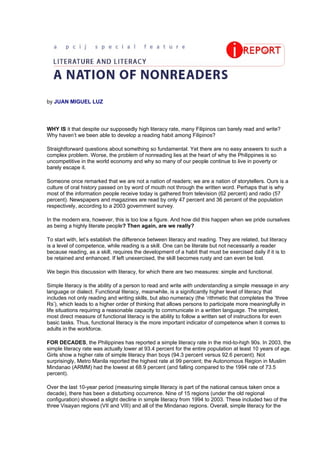
A Nation Of Nonreaders By Juan Miguel Luz
- 1. by JUAN MIGUEL LUZ WHY IS it that despite our supposedly high literacy rate, many Filipinos can barely read and write? Why haven’t we been able to develop a reading habit among Filipinos? Straightforward questions about something so fundamental. Yet there are no easy answers to such a complex problem. Worse, the problem of nonreading lies at the heart of why the Philippines is so uncompetitive in the world economy and why so many of our people continue to live in poverty or barely escape it. Someone once remarked that we are not a nation of readers; we are a nation of storytellers. Ours is a culture of oral history passed on by word of mouth not through the written word. Perhaps that is why most of the information people receive today is gathered from television (62 percent) and radio (57 percent). Newspapers and magazines are read by only 47 percent and 36 percent of the population respectively, according to a 2003 government survey. In the modern era, however, this is too low a figure. And how did this happen when we pride ourselves as being a highly literate people? Then again, are we really? To start with, let’s establish the difference between literacy and reading. They are related, but literacy is a level of competence, while reading is a skill. One can be literate but not necessarily a reader because reading, as a skill, requires the development of a habit that must be exercised daily if it is to be retained and enhanced. If left unexercised, the skill becomes rusty and can even be lost. We begin this discussion with literacy, for which there are two measures: simple and functional. Simple literacy is the ability of a person to read and write with understanding a simple message in any language or dialect. Functional literacy, meanwhile, is a significantly higher level of literacy that includes not only reading and writing skills, but also numeracy (the ‘rithmetic that completes the ‘three Rs’), which leads to a higher order of thinking that allows persons to participate more meaningfully in life situations requiring a reasonable capacity to communicate in a written language. The simplest, most direct measure of functional literacy is the ability to follow a written set of instructions for even basic tasks. Thus, functional literacy is the more important indicator of competence when it comes to adults in the workforce. FOR DECADES, the Philippines has reported a simple literacy rate in the mid-to-high 90s. In 2003, the simple literacy rate was actually lower at 93.4 percent for the entire population at least 10 years of age. Girls show a higher rate of simple literacy than boys (94.3 percent versus 92.6 percent). Not surprisingly, Metro Manila reported the highest rate at 99 percent; the Autonomous Region in Muslim Mindanao (ARMM) had the lowest at 68.9 percent (and falling compared to the 1994 rate of 73.5 percent). Over the last 10-year period (measuring simple literacy is part of the national census taken once a decade), there has been a disturbing occurrence. Nine of 15 regions (under the old regional configuration) showed a slight decline in simple literacy from 1994 to 2003. These included two of the three Visayan regions (VII and VIII) and all of the Mindanao regions. Overall, simple literacy for the
- 2. Table 1. Simple Literacy Rate (for the population aged 10 years and older) Source: National Statistics Office YEAR ALL (%) BOYS (%) T GIRLS (%) H E p r o bl e m 1994 of 93.9 n 93.7 o 94.0 n re a di n g li e 2003 s 93.4 at 92.6 th 94.3 e h e ar t of w h y th e P hi li p entire country fell by 0.5 percent from 1994 to 2003. pi n (See Table1) e s is What do these numbers mean? Based on a s population of 80 million, 6.6 percent illiteracy o translates into 5.3 million Filipinos who cannot read or u n write; a number that grew by about 1.6 million over c the past decade. o m p I suspect, however, that our simple literacy rate might et even be overstated, meaning there may be even iti more Filipinos incapable of reading and writing a v e simple message, with understanding, than reported in officially. The measure of simple literacy, after all, is th not determined by a test but rather by a census e w question. A census-taker asks respondents: “Can you o read or write a simple message in any language or rl dialect?” It’s easy to imagine that quite a number of d e household heads would answer affirmatively to hide c the fact that they are illiterate, out of a feeling of hiya o (shame). And I do not think census-takers take the n o time to test the literacy level of a respondent during m the survey. y a n Professor Dina Ocampo of the University of the d w h y s o
